020 was a hell of a year. For movies it certainly wasn’t ideal, and I think we all know why. In putting together this, the latest edition of my Year in Bedlam overview of the previous year’s movies, I found that in this unprecedented situation the small and obscure film releases I tend to favor were actually more easily accessible than the big Hollywood releases. For the record, 2020 releases I missed include THE NEW MUTANTS, WONDER WOMAN 1984 and UNHINGED.
Another way in which this Year in Bedlam differs from its predecessors is in the self-imposed rules about my movie choices. I’ve always made a concerted effort to stick with commercially released non-festival releases, but this time around I’ve simply tried to see as many 2020 releases as I can, and group them accordingly. And yes, I’ve also included the standard DVD/Blu-ray recommendations and mentions of upcoming films that sound promising—although in both cases the 2020 pickings were far slimmer than those of previous years. So with that out of the way…
The Best:
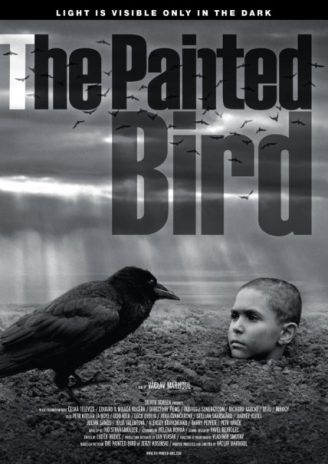 1. THE PAINTED BIRD
1. THE PAINTED BIRD
A near three hour adaptation of Jerzy Kosinski’s 1965 novel THE PAINTED BIRD by writer-director Václav Marhoul, who’s rendered Kosinski’s gruesome and unforgiving text in prestige movie fashion. The film is the first to be presented in the Interslavic language (because, according to Marhoul, “I didn’t want some nation to be associated with” the awfulness depicted). The opening scene, in which the young Joska (Petr Kotlár) has his pet ferret burned to death by bullies, adequately sets the tone. Joska, we learn, has been separated from his Jewish parents, and left to wander from one horrific situation to the next. Literally everyone Joska meets—superstitious peasants, corrupt priests, sadistic educators and trigger-happy military men (allied and otherwise)—is petty, ignorant, depraved or all three, leading to abuse of every conceivable stripe. All of this is depicted in beautifully lit and composed black and white imagery, courtesy of cinematographer Vladimír Smutný, whose work goes well with the stately pacing and handsome art direction. Whatever else this film may be, it’s certainly among the most sumptuously mounted collection of horrors ever committed to cinema. Ultimately THE PAINTED BIRD is unique among WWII films, as it’s not a black comedy (a la the similarly themed EUROPA EUROPA), nor a historical saga (a la COME AND SEE), nor a hallucinatory drama (a la DIAMONDS OF THE NIGHT). Rather, this film’s only real point of comparison is to its own nasty, unsparing and ultimately quite brilliant self.
2. PINOCCHIO
Here Italy’s Matteo Garrone sought to adapt Carlo Collodi’s immortal ADVENTURES OF PINOCCHIO in its original un-Disneyfied form, i.e. as a dark and surreal fantasy. Roberto Benigni plays Gepetto, a genial fellow looking to become a puppeteer. He gets his chance when he’s given a sentient piece of wood, which Gepetto carves into a boy named Pinocchio. This puppet-boy, alas, is a bit of a twerp who impulsively wanders off to explore a world in which animals can talk and, as we all know, is afflicted with a nose that grows whenever he tells a lie. The film is marked by an eye for telling visual detail and production design that has a lived-in feel, with Garrone’s painstakingly achieved sense of earthy realism serving to enhance the tale’s underlying strangeness. Pinocchio, as played by Federico Ielapi, is a marvelous creation: his carved wooden surface is convincingly rendered with visible wood grain and very human eyes, while the many talking animals who turn up are depicted as humans with animal features (or vice-versa). It doesn’t all work, but the film hits its target enough that it can safely be designated the screen’s premiere live action PINOCCHIO.
3. THE PLATFORM (EL HOYO)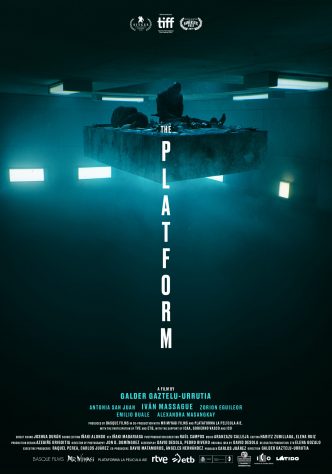
This Spanish language science fiction mindbender is in the tradition of Vincenzo Natali’s CUBE. Like that film, this one melds an imaginatively minimalistic premise with transcendent intelligence and a social conscience, with wealth inequality, racism and collectivity all factored in. The overriding theme is, simply, sustenance, a subject that has never been more forcefully or provocatively explored. The setting is a multi-level enclosure built around a vast hole, whose most noteworthy feature is a platform filled with gourmet food that descends from the top of the structure, leaving progressively less food for the inhabitants of the lower levels. Each month those inhabitants get moved to different floors, seemingly by random selection. The cells heat up whenever somebody attempts to keep a bit of food for him or herself, although nothing happens when people fight or cannibalize each other. All this results in a slick and oppressive film whose various components don’t entirely add up, but whose ultimate impact is nearly as large as the hole that figures so prominently in its conception.
4. INMATE #1: THE RISE OF DANNY TREJO
A documentary profile of onetime criminal and all-time badass Danny Trejo, who spent eleven years of his life behind bars. Trejo’s places of incarceration included some of the most notorious prisons in America, forging a tough, but also well-rounded and compassionate, individual. Now a free man, Trejo is a prolific actor with (no joke) 384 screen credits, the best known of which occur in MACHETE (2010) and its sequel. Director Brett Harvey provides a good accounting of Trejo’s unlikely success in Hollywood, and a satisfying overview of his none-too-settled childhood. Unabashedly pro-rehabilitation (a pretty radical stance nowadays), this film powerfully evokes both the ugliness of prison life and the capacity for change in a life that’s like no other.
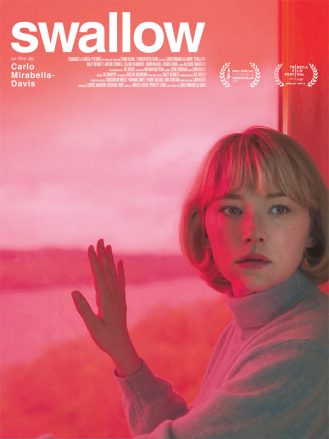 5. SWALLOW
5. SWALLOW
The subject of this indie horror fest is the Pica eating disorder, meaning a compulsion to eat inedible things. The sufferer is a richer-than-God businessman’s pregnant trophy wife (Haley Bennett), who takes to swallowing a marble, a thumbtack, lipstick, paper and other household objects. Writer/director Carlo Mirabella-Davis situates this bleak account in an unnervingly staid, antiseptic atmosphere of gilded opulence that’s as potent as any old dark castle setting. It’s grounded by the towering performance of Ms. Bennett (an actress that, as we’ll see, appeared in several 2020 films), whose acting is marked by impeccably defined minimalism and a screen presence that compels attention even when very little is happening. Bennett is so impressive that it’s quite frustrating when the final scenes, in which she faces up to a figure from her past in a weepy confrontation, close out this stylish and disturbing film on an asynchronous TV movie note.
6. THE LAST BLOCKBUSTER
It’s probably wrong to be nostalgic about Blockbuster, the corporate behemoth that dominated the video rental business in the 90s and much of the 00s, but I couldn’t help but get a little misty-eyed watching this documentary about the world’s last remaining Blockbuster Video outlet. The place, located in Bend, OR, is run by one Sandi Harding, whose persistence has made her a most unlikely media darling, and her store a popular tourist attraction. Also provided is a history of Blockbuster, and the video rental business overall, with commentary by Kevin Smith, Ione Skye, Jamie Kennedy and others (Troma’s Lloyd Kaufman is also on hand to offer a dissenting anti-corporate view). The film is never very deep or in-depth in its approach, registering as a pleasant surface-level exploration of an independently operated mom and pop establishment, i.e. precisely the type of business that Blockbuster in its heyday tried so hard to stamp out.
7. DOGS DON’T WEAR PANTS (KOIRAT EIVAT KAYTA HOUSUJA)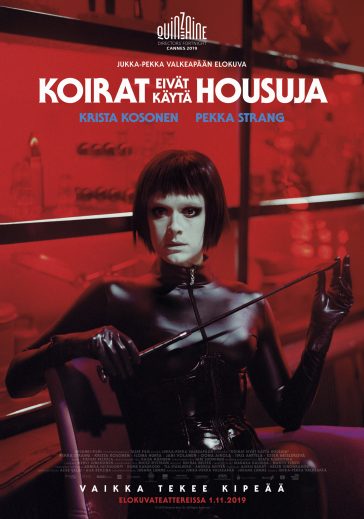
In this very eccentric Finnish import a grief-stricken man (Pekka Strang) finds solace, and eventually love, after the death of his wife in the arms of a dominatrix. This unlikely courtship undergoes a number of stages, progressing from impersonal to perverse, dangerous and, finally, healthy and beneficial to both parties. Director J.P. Valkeapää proves himself a wizardly visual storyteller, conveying complex psychological states through imagery that is at times quite beautiful (as when Strang, during a torture session, is shown communing with his dead wife in the lake in which she drowned). To his credit, Valkeapää doesn’t shy away from the uglier aspects of his premise, with graphic depictions of burning, asphyxiation and, in the film’s most spectacularly unpleasant sequence, tooth pulling. The extremely quiet and deliberate style is impressively rendered, but also a bit off-putting, making the film seem much longer than it actually is.
8. HAPPY HAPPY JOY JOY: THE REN & STIMPY STORY
A doco about the legendarily irreverent animated program REN & STIMPY and its genius creator John Kricfalusi. Like many a genius before him, Kricfalusi eventually lost his way (and, evidently, his mind), alienating both his crew and his superiors, and developing a lamentable attraction to underaged girls. This film features extensive interviews with a defeated-looking Kricfalusi and his former co-workers, as well as plenty of footage from REN & STIMPY, showing that it is indeed a program worth documenting. Complaints have been aired about the filmmakers failing to fully take Kricfalusi to task for his sins, but I say their non-judgmental approach is correct; Kricfalusi’s pervy behavior may be impossible to excuse, much less ignore, but it doesn’t lessen the brilliance of his output.
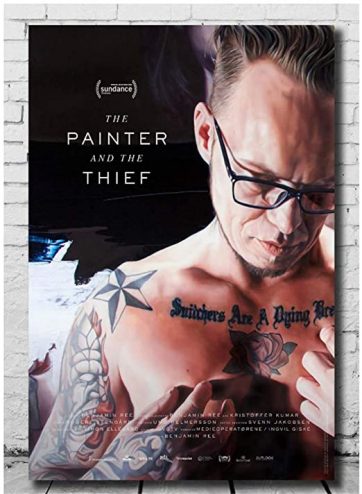 9. THE PAINTER AND THE THIEF
9. THE PAINTER AND THE THIEF
Documentaries simply don’t get much more provocative or absorbing than this Norwegian import, which examines what occurs when Barbora Kysilkova, a painter, has two of her canvases stolen by Karl Bertil-Nordland, a petty thief. He’s caught, and confronted in court by Kysilkova, who makes a most unexpected request: she wants to paint him. This makes for an excellent jumping-off point for a film that pivots on unpredictability. As the relationship between these two develops, we learn that Bertil-Nordland is far more cultured and soulful than he initially seems, while Kysilkova isn’t nearly as together as she might appear. Among other issues, she has an unfortunate history of entering into abusive relationships, and appears to be cultivating another with Bertil-Nordland. The reality, of course, is far more complex than such a reading suggests. Kudos to director Benjamin Ree, who renders this account without sanitization or apology.
10. THE KING OF STATEN ISLAND
I’ll give this film a nod, even though it’s obnoxiously overlong (136 minutes!) and meandering. It’s a Judd Apatow directed autobiographical ramble by SATURDAY NIGHT LIVE’s Pete Davidson, exploring his pre-SNL years in Staten Island. As depicted here, this 24 year old loser lives in poverty with his nurse mother (Marisa Tomei, currently Hollywood’s go-to movie mom); both have been severely traumatized by the death of Davidson’s firefighter father, with he now suffering from a variety of ailments physical and mental, and not taking at all kindly to his ma’s new boyfriend (Bill Burr). The film explores its protagonist’s issues, but never too deeply, with Apatow, as is his custom, lavishing most of the screen time on heavily ad-libbed banter. Much of it is actually funny, and the pleasantly self-effacing Davidson is impossible not to like. Plus the cinematography by Robert Elswitt is impressive, depicting an East Coast white trash milieu that feels quite authentic.
11. FAMILY ROMANCE, LLC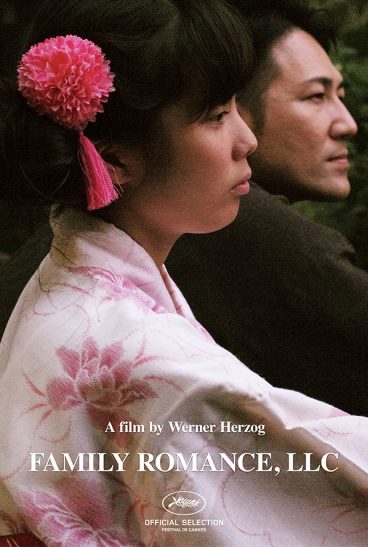
This drama from the great Werner Herzog plays like a particularly bizarre flight of fancy, but is based staunchly on fact. The setting is Japan, where a company specializes in hiring actors to impersonate family members, wedding dates, paparazzi, etc. The film may be fictional, but the company at its center is entirely real, as is its CEO and lead actor Ishii Yuichi, who plays himself. Herzog’s control isn’t as absolute as it usually is; the proceedings are quite uneven, with lengthy scenes of Yuichi engaging in pretend conversations with clients that are evidently supposed to be far more interesting than they actually are. Yet the strangeness, fascination and sadness of the subject matter are consistent throughout.
12. THE LAST WOLF: KARL EDWARD WAGNER
A documentary that probably won’t appeal to general audiences, but for horror nerds it’s a veritable goldmine. Profiled is the late horror scribe Karl Edward Wagner (1945–1994), a writer of undeniable (if only partially fulfilled) brilliance who was done in at age 48 by his own bad habits. Directors Brandon D. Lunsford and Brian M. McKnight include interviews with Wagner’s surviving friends, family members and ex-wife, as well as his fellow horror specialists Stephen Jones, Dennis Etchison, Peter Straub, Ramsey Campbell and S.T. Joshi. It’s not anyone’s idea of cinematic innovation, but the film does just what it needs to in illuminating a highly varied, individual and tragic life.
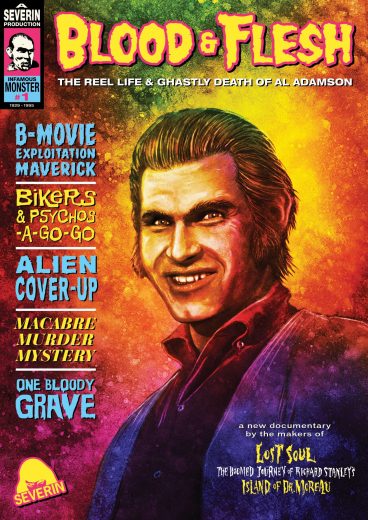 13. BLOOD AND FLESH: THE REEL LIFE & GHASTLY DEATH OF AL ADAMSON
13. BLOOD AND FLESH: THE REEL LIFE & GHASTLY DEATH OF AL ADAMSON
A straightforward documentary by Severin Films’s David Gregory, about the late B-movie maestro Ad Adamson. Given that Gregory specializes in DVD docs, it shouldn’t surprise anyone that that’s very much how BLOOD AND FLESH plays, with various Adamson cast members and acquaintances chatting about him, and clips from his films employed to punctuate their reminisces. What distinguishes BLOOD AND FLESH are the circumstances of its subject’s death, which are involved enough that the film’s final third essentially becomes a true crime account, with extensive commentary from police officers and news reporters, and a tone that goes from celebratory to oppressive. But Gregory really knows how to do this sort of thing, turning out a consistently absorbing film that accomplished the seemingly impossible feat of getting me jazzed about the work of a filmmaker who until now has interested me very little.
14. MANK
No, this isn’t the transcendent masterpiece the pre-release hype portended, but it is pretty damn good. It’s David Fincher’s made-for-Netflix dramatization of the writing of CITIZEN KANE, filmed in sumptuous black and white with equally sumptuous period detail. Scripted by Fincher’s late father Jack, the film takes the controversial view that Herman Mankiewicz, credited as co-writer on KANE, was in fact the film’s true auteur, and its co-writer/director Orson Welles a grandstanding blow-hard. Gary Oldman plays “Mank,” a brilliant but self-destructive alcoholic whose odyssey through Hollywood in the 1930s, and his encounters with players like Upton Sinclair (Bill Nye—yes, that Bill Nye), Louis B. Meyer (Alriss Howard), Marion Davies (Amanda Seyfried), William Randolph Hearst (Charles Dance) and Welles (Tom Burke), are intercut with his attempts at writing the KANE script with the help of a fetching British assistant (Lily Collins). All this seems a bit disjointed initially, but eventually coalesces as it becomes clear that everything we’re being shown made its way, in some form, into KANE’s screenplay. Thus a thorough knowledge of CITIZEN KANE is required to make sense of MANK, and also a rooting interest in old Hollywood; this explains why the film, heavily hyped though it was, has made little headway on the Netflix viewing chart (upon which it debuted at the bottom of the top 10, and hasn’t reappeared since).
15. THE HUNT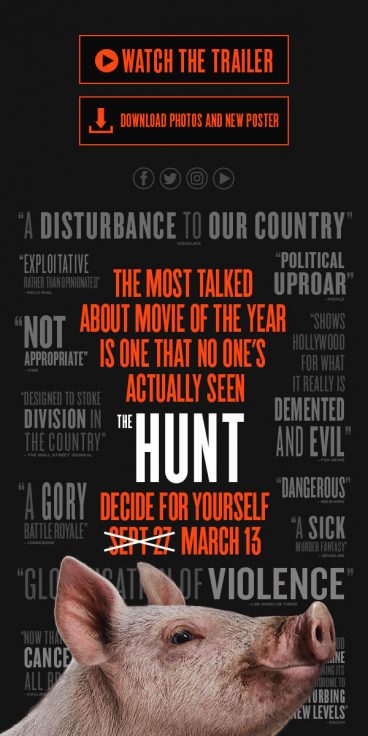
A fun, ultraviolent satire that made headlines when it was pulled from its initial release (leading to the tagline “The Most Talked About Movie of the Year is One That No One’s Actually Seen”). It’s certainly incendiary, being a satire of America’s polarized political climate at a time when neither side can seem to take a joke. That satire is extremely broad and caricatured, but mostly dead-on in its skewering of both the left and the right, with the former depicted sitting around hand-wringing about cultural appropriation and white privilege, and the latter agonizing over the latest alt-right conspiracy theory. The situation is a gambit organized by a band of ultra-leftists who kidnap several high-profile right-wingers and hunt them through a remote forest. This entails a great deal of over-the-top gore and one of the screen’s best-ever gal-on-gal fights, with Hilary Swank and Betty Gilpin doing the honors quite ably.
16. BLOOD MACHINES
A truly eye-popping three part viewing experience from director Raphaël Hernandez, a.k.a. Seth Ickerman, and composer Carpenter Brut. In “Mima” we’re introduced to a sentient space cruiser with an all-female crew battling a hostile warship, while in “Corey” the inhabitants of the warship, having gained the upper hand, take one of Mima’s inhabitants hostage and, in “Tracy,” said hostage reveals unexpected supernatural abilities. The film, despite a number of outright steals from past movies (ALIEN, BLADE RUNNER, SILENT RUNNING and DARK STAR are all referenced), is a visual stunner with terrifically organic H.R. Giger-esque space ship design and CGI that’s among the finest you’ll ever see. But we mustn’t forget that this is a science fiction film, meaning I’ll have to air a complaint that tends to recur when discussing such fare: the lack of any real humanity in either the conception or the characterizations, a factor that isn’t helped by the bad actors, who are called upon to mouth heavily accented, oft-incomprehensible English dialogue.
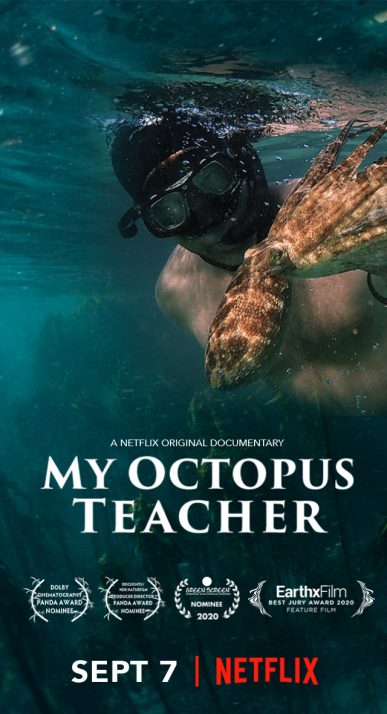 17. MY OCTOPUS TEACHER
17. MY OCTOPUS TEACHER
One of 2020’s major Netflix sensations was this documentary about diver Craig Foster’s relationship with an African octopus. It plays like essentially what it is: the quirkiest nature doco ever, with info about the octopus’s habits and genetic make-up juxtaposed with Foster’s personal recollections. He claims to feel a special kinship with the octopus, and makes a compelling case that the critter feels the same way about him. The film isn’t terribly exciting from a formal standpoint, cutting back and forth as it does between a chatty Foster seated at a table and his underwater footage, but it is oddly compelling and even touching (albeit not nearly as much as the media coverage of the film might have you believe).
18. TENET
A most unlikely candidate for Savior of the Movie Industry, which is precisely the role in which Christopher Nolan’s sci-fi thriller TENET was cast when it opened in September. It shouldn’t surprise anyone that the film failed to single-handedly prop up an industry hit quite hard by the coronavirus, and it’s now being dumped on rather spectacularly. In truth TENET is far from great, but it isn’t bad, either. At its core is a highly involved and confusing time travel rationale that involves events occurring backwards. It seems to me that Nolan could have done a lot more with that conception than he does (especially given the reported $200 million budget), but the film is enjoyable enough, with fights, car crashes and explosions that maintain one’s attention despite the fact that the narrative is quite hard to follow. In short, TENET works best as the type of empty-headed action spectacle it purports to transcend.
19. COLOR OUT OF SPACE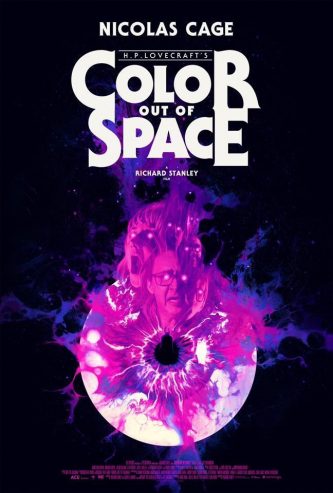
The first feature in over 25 years to be directed by Richard Stanley. COLOR OUT OF SPACE, adapted from H.P. Lovecraft’s immortal 1927 tale, is a flawed but worthwhile film, being the work of a talented filmmaker we’re lucky to have back in our midst. Nicolas Cage plays an alpaca enthusiast living in a forest mansion with his family, who go collectively mad when a meteor crashes in the front yard. Also turning up is some mighty strange vegetation, polluted water and animals that act as strangely as Cage. What’s most striking about the film is its subtlety; the pacing and storytelling are quite stately, which makes it all the more disappointing that the proceedings devolve into a noisy and undisciplined special effects barrage. A large part of the problem is that from a narrative standpoint the material is inherently flawed, with the Lovecraft text being a plotless a mood piece (which explains why a fully satisfying adaptation has yet to appear).
20. BORAT SUBSEQUENT MOVIEFILM
The more-of-the-same sequel to BORAT, of note because it plays directly into 2020 angst, and because of a most unexpected asset: actress Maria Bakalova, who handily steals the film. She plays Tutar, the daughter of Sacha Baron Cohen’s Borat, who as in the previous film heads from his Kazakhstan homeland to the US. His object is to pimp Tutar out to Mike Pence, resulting in a number of misadventures involving a colorful assortment of hicks and rednecks. As before, the gimmick is that Borat and Tutar’s encounters with these people are all entirely real, including a fertility ritual Tutar performs at a father-daughter dance while on her period, during which she flashes her bloody underwear to the stunned crowd, and her already famous encounter with Rudy Giuliani in which he’s seen lying on a bed and digging in his pants. The film is far more politically motivated than its predecessor (I wouldn’t dream of revealing which side it favors), although the major joke is that Bakalova speaks in her native language of Bulgarian whenever she’s alone with Cohen, while he speaks Hebrew, something American viewers (this one included) have been slow to pick up on.
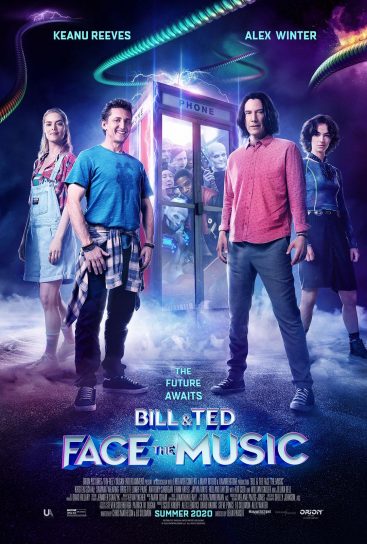 21. BILL AND TED FACE THE MUSIC
21. BILL AND TED FACE THE MUSIC
A new BILL AND TED movie, appearing nearly thirty years after the last (1991’s BILL AND TED’S BOGUS JOURNEY). Here we’re asked to believe that the now middle aged Bill (Alex Winter) and Ted (Keanu Reeves) still hang out together, and still haven’t learned to play any instruments despite the fact that their music is fated to somehow unite the world. The filmmakers give B&T wives and daughters who frequently take control of the narrative, and so give the title characters some time off—a most welcome development, as Winter and Reeves’s eighties slacker shtick has long since grown tiresome. There’s also an imaginative script by Chris Matheson and Ted Solomon, which deals fairly intelligently with concepts like reality degeneration and time travel displacement, and ties it all up in a satisfying manner that convincingly delineates precisely how B&T’s music serves to unite the world.
22. THE LODGE
A new feature from Severin Fiala and Veronika Franz, the writer/directors of the infamous kids-torturing-their-mother freak-out GOODNIGHT MOMMY (2014). A similar sensibility is evident in THE LODGE, an unremitting claustrophobia-fest set in a secluded forest lodge in the dead of winter. There a young woman (Riley Keough) and her soon-to-be stepchildren (Lia McHugh and IT’s Jaeden Martell) are stuck in a snowstorm, together with some unquiet ghosts. In exploring this situation Fiala and Franz address its every conceivable wrinkle (are the kids evil? Is Keough? Or is all the creepiness just the ghosts acting up?), with their true concern being the realities of madness and oppression rather than cheap scares. For that reason the film deserves to be seen, in addition to the fact that it’s superbly atmospheric and not a little unnerving. The performances of Riley Keough and the two youngsters are great, and there’s also a memorable turn by Alicia Silverstone (an actress for whom Keough is often mistaken) in a small role as the kids’ suicidal mother. Given such a wealth of good things, I’ll politely overlook the film’s more glaring flaws, such as the meandering narrative and over-similarities to THE SHINING (which, FYI, is directly referenced in the family dog Grady, named after the ghostly caretaker therein).
23. CAPONE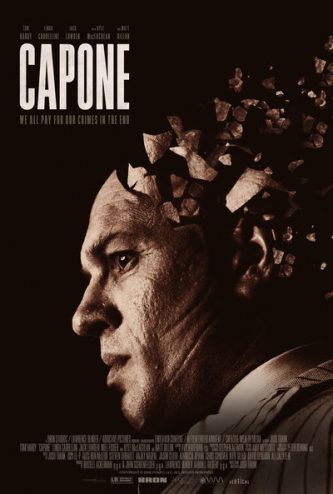
A “harrowing and true untold story” (as this film’s ad copy eagerly states) of Al Capone? Not exactly, although it’s safe to say there’s never been a gangster movie like this one, about an ailing Capone in his final year of life. CAPONE marked a comeback of sorts for writer-director Josh Trank, who made a splash with CHRONICLE in 2012 but flamed out rather spectacularly with the failed 2015 FANTASTIC FOUR reboot. Tom Hardy, who’s all-but cornered the market on portrayals of real-life criminals, does a convincing incarnation of an ailing Al Capone, speaking in a raspy croak and moving in a way that seems authentically old mannish. Action and violence are provided by copious (and oft-bloody) hallucinations and flashbacks, while the here-and-now scenes, dominated by a drooling, farting and babbling Capone, have a definite geek show fascination. If nothing else, this is certainly the only film to feature a tommy gun rampage conducted by a diaper-wearing invalid, and I say that’s a sight worth seeing.
24. THE DECLINE (JUSQU’AU DECLIN)
Had this crisp and efficient thriller appeared in the 1970s it would likely have been called “in the tradition of DELIVERANCE,” as it contains definite echoes of that 1972 classic, as well as the many films it inspired, such as SHOOT (1976) and RITUALS (1977). The feature debut of director Patrice Laliberté, THE DECLINE is set in a wilderness survival camp where a half-dozen “enlightened citizens” are gathered to train in self-defense, shooting and explosives. The latter element comes into play during a morning training exercise that goes horrifically wrong, with a man fatally injured by a mistimed detonation, and paranoia and institutional distrust overtaking the group. The actions of the principal characters are convincing for the most part, although the third act bungling of many of these would-be survivalists seems a bit hard to believe, and takes place amid forest scenery that all looks the same. But the bad things are outweighed by the good, foremost among them Laliberté’s frank approach to violence. A Hollywood thriller this isn’t, and that, in my view, is a definite point in THE DECLINE’S favor.
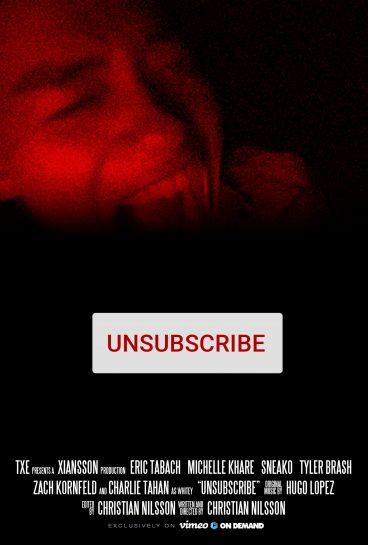 25. UNSUBSCRIBE
25. UNSUBSCRIBE
A zero budgeted 29 minute film that made headlines for being the number one movie in America during the week of June 10 (the filmmakers booked it into a single theater and bought out all the screenings, which was apparently enough to beat out everything else). The pic is surprisingly not-bad, being a tight and suspenseful account of a Zoom meeting, one of whose participants is a mysterious, and possibly homicidal, troll. I actually prefer UNSUBSCRIBE to its most visible predecessor, 2014’s UNFRIENDED, and 2020’s other major zoom thriller HOST (see below).
26. CIRCUS OF BOOKS
This Netflix doco is an unremarkable, but quite likeable and entertaining, depiction of West Hollywood’s late Circus of Books. A longtime LA fixture located on Santa Monica Boulevard (with further outlets in Silver Lake and Sherman Oaks), CoB was an adult bookstore run by Karen and Barry Mason, a nice Jewish couple who through an odd chain of circumstances became major purveyors of gay pornography—despite the fact that Karen Mason was deeply religious and not a little homophobic. This film was made by the Mason’s daughter Rachel, who does a good job laying out the history of her parents’ business and her own reaction to it, as well as the gay clientele who found solace and acceptance in the store. Another theme explored is the anti-pornography fervor that overtook the nation in the eighties and nineties, and very nearly got the Masons thrown in jail. The film concludes with the closing of Circus of Books after thirty years of business, marking a true end of an era.
27. THE DEVIL ALL THE TIME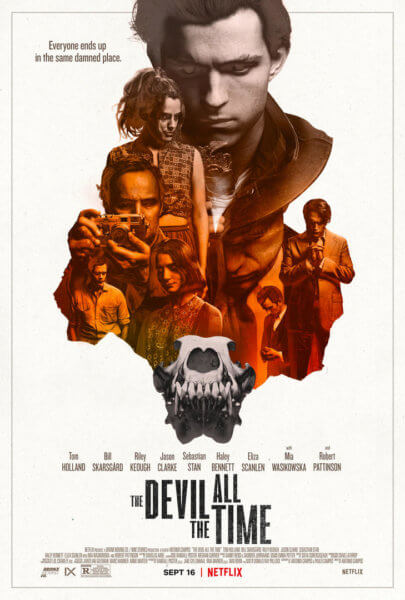
An adaptation of Donald Ray Pollock’s “country noir” classic about a troubled young man (Tom Holland) living in a godforsaken southern town in the 1960s. Orbiting him are a retinue of perverts, killers and assorted eccentrics, played by an impressive roster of talent that includes Robert Pattinson, Riley Keough, Haley Bennett and Mia Wasikowska (all sporting fake southern accents). This is very much an A-list project, with handsomely mounted visuals that somewhat offset the darkness and sleaze of the narrative, which contains every imaginable outrage. The film suffers from wobbly and episodic storytelling in the early scenes—taken up with a riot of jumps back and forward in time—and it continues in that stop-and-start manner for the remainder of the two hour-plus runtime. But it’s a bold piece of work, and amid Netflix productions a definite step in the right direction.
28. THE DAY OF DESTRUCTION/HAKAI NO HI
This 57 minute film from producer-director Toshiaki Toyoda was intended to mark the July, 2020 opening of the Tokyo Olympics. The coronavirus, however, turned the film into something else entirely. It begins with an insanely protracted four minute series of tracking shots through an underground mine where a monster, in the form of an indistinct twitching mass, resides. Seven years later the critter has become trapped belowground via an earthquake, but exerts its influence in the form of a mysterious aboveground epidemic. All this is presented in a highly ritualistic manner that pays more attention to rhythm and symbolism (included is a shot of the quarantined Diamond Princess Cruise ship, to make absolutely sure we understand the covid connection) than it does narrative trappings. This results in a confusing and not-entirely-satisfying film, although Toyoda’s cinematic prowess, evident in the sumptuous widescreen imagery and impeccable use of music, is quite something to behold.
Recommended DVD Releases:
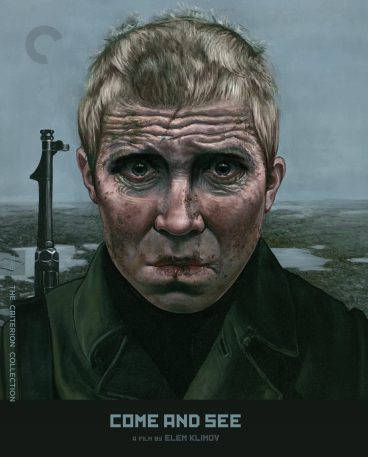 COME AND SEE
COME AND SEE
One of the greatest movies ever is given the Criterion treatment, resulting in a Blu-ray that far supersedes any and all previous home video releases.
THE COMFORT OF STRANGERS
I’m not hugely enamored with this subdued Paul Schrader thriller, but it is a visually enticing film that I don’t recall ever looking better than it does in this newly minted Criterion release.
CRASH
Another Criterion must-have: David Cronenberg’s 1996 J.G. Ballard adapted masterpiece, distinguished by the fact that this release contains the long out of print laserdisc audio commentary.
THE CREMATOR
Yet more Criterion goodness, lavished upon a most deserving film: Juraj Herz’s stark and disturbing 1969 black comedy about a Central European cremator losing his mind in WWII.
D.C. CAB
I’ve always enjoyed this rambunctious 1983 comedy from the late Joel Schumacher, which in 2020 finally got Blu-ray’d. It has one of the wildest casts ever, with Gary Busey, Mr. T, Bill Maher, Max Julien and Timothy Carey all taking their turn.
DIARY OF A MAD HOUSEWIFE
The long-awaited Blu-ray edition of a classic black comedy by director Frank Perry, with a GREAT performance by Carrie Snodgress.
FELLINI’S CASANOVA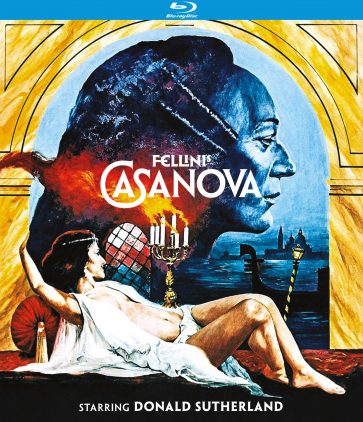
Not one of Federico Fellini’s best films, but even second-tier Fellini is worthwhile. I haven’t yet viewed this Blu-ray release, but I’m certain it will be preferable to the VHS bootlegs with which we Americans have had to make do.
LADYBUG LADYBUG
One of the greatest, and most underrated, films of the 1960s, a devastating fact based portrait of nuclear apprehension from the aforementioned Frank Perry. He was a director who could create magic when he was inspired, and he was definitely inspired here.
PUZZLE OF A DOWNFALL CHILD
One of several attractive-women-having-nervous-breakdown movies to emerge from the 1970s (a category that includes PLAY IT AS IT LAYS and the abovementioned DIARY OF A MAD HOUSEWIFE). This one stars Faye Dunaway, and (I’m told) has been well digitized.
The Worst:
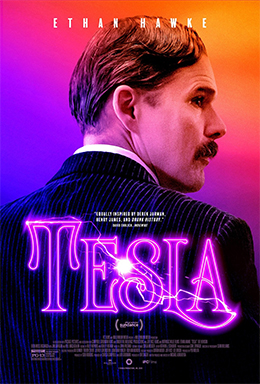 1. TESLA
1. TESLA
In which writer-director Michael Almereyda attempted a biopic about Nikolai Tesla, and failed pretty spectacularly. The film’s problems start with the casting of Ethan Hawke as the Austrian born Tesla and Kyle MacLachlan as his rival Thomas Edison. Neither actor is the slightest bit convincing, and nor is the early 20th Century period detail. It certainly doesn’t help matters that Almereyda insists on filtering Tesla’s story through a morass of self-conscious experimentation, with a narrative that freely interweaves past, present and thoroughly misguided fantasy—Hawke doing a morose rendition of “Everybody Wants to Rule the World” plays just like it sounds.
2. DA 5 BLOODS
A film that could have emerged full blown from the late 1960s, when free-form political screeds masquerading as dramatic narratives were quite prevalent. The director was Spike Lee, who sought to tell the story of black men in Vietnam and remake THE TREASURE OF THE SIERRA MADRE, while also commenting on our present realities. This entails a lot of documentary snippets and sociological commentary, crowbarred into a story about five black veterans looking for buried treasure in modern-day Vietnam. Some great actors are involved, among them Delroy Lindo, Jean Reno and the late Chadwick Boseman, but they function more as mouthpieces for Lee’s political concerns than characters, and play themselves in the flashback scenes without any aging effects, thus rendering an already confusing and disjointed film even more so. Some good bits inevitably make their way through this morass of self-indulgence, such as an authentically suspenseful landmine sequence and a well calibrated climactic shoot-out, but the vastly inflated 154 minute runtime ensures that they fail to make any lasting impression.
3. BIRDS OF PREY: AND THE FANTABULOUS EMANCIPATION OF ONE 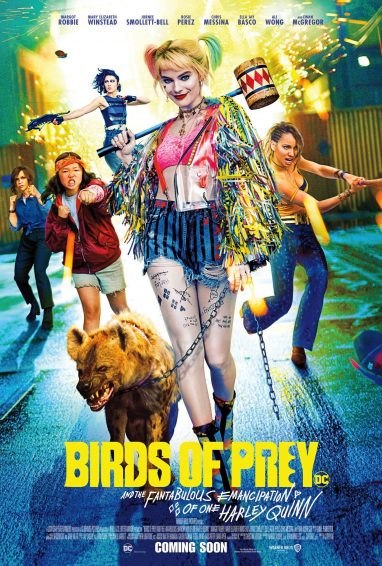 HARLEY QUINN
HARLEY QUINN
If DA 5 BLOODS is redolent of the 1960s, BIRDS OF PREY feels straight out of the 90s. For those of you who remember TANK GIRL (1995), this is its logical successor, an enormously self-satisfied, semi-coherent comic book phantasmagoria that revels in forced edginess. Set in a shockingly drab and indistinct Gotham City (note how in a climactic car chase nearly every shot features the same parking structure passing by in the background), it has Margot Robbie reprising her role of Harley Quinn, a supporting player in SUICIDE SQUAD who was unwisely given center stage here. Her boyfriend the Joker was, in another bonehead move, given the boot, in favor of—yet another questionable decision—a trio of thoroughly bland super gals with nothing interesting in the way of costumes or abilities. Clearly this film could have done with a serious rethink, if not several.
4. SHE DIES TOMORROW
A horrific mood piece by actress/director Amy Seimetz. It received a great deal of overwrought praise from pundits eager to show their support for Seimetz, which had the unfortunate effect of creating vastly outsized expectations for a film that is small in every sense of the word. Headlining is Kate Lyn Sheil as a young woman haunted by the belief that she’s not long for this world. This leads to a lot of horrific visions as her apprehensions spread virus-like to her friends and acquaintances. Seimetz’s meticulousness is evident in the varying sound levels and overriding atmosphere of anxiety and desolation. Not all of her artistic choices pay off, but for the most part Seimetz succeeds in her aims; the problem is those aims are far too modest and esoteric to make for a satisfying film.
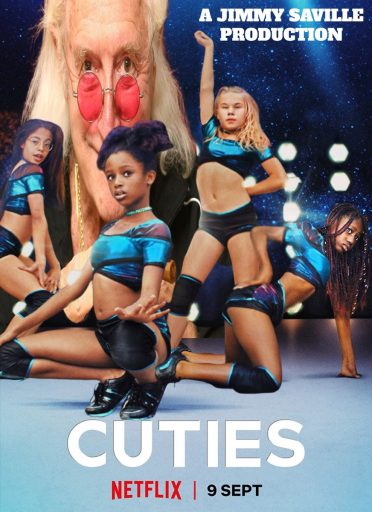 5. CUTIES (MIGNONNES)
5. CUTIES (MIGNONNES)
A French Netflixer that has outraged both liberals and conservatives in equal measure. The reason for all the strife, for the few of you who don’t know, is the film’s depiction of eleven year old girls doing overtly sexual dances, presented with an unnatural emphasis on the girls’ nether regions. The film’s obsession with underage crotch shots is indeed quite questionable and disturbing, but the real problem is there’s not much to it otherwise. It centers on a young African immigrant girl in Paris, where she falls in with some wannabe dancers whose influence leads her away from the sphere of her traditional mother. It is, in short, a story that has been told before (see CHRISTIANE F., SMOOTH TALK, THIRTEEN and quite few other films), and better.
6. THE WITCHES
In the annals of unnecessary remakes this one, of the 1990 Roald Dahl adaptation THE WITCHES, ranks pretty high on the pointlessness meter. About a young boy (Jahzir Bruno) coming into contact with an Anne Hathaway led coven of witches, it brings very little to the table that the previous film didn’t, outside a fine performance by Octavia Spencer as the boy’s grandmother and a political angle, involving the witches preying on poor people, that’s discarded after about a half hour. Director Robert Zemeckis tries to keep us occupied with a “more is more” aesthetic, denoted by overwrought CGI (bodily transformations are depicted by having the participants launched into the air and emitting smoke) and much shameless over-emoting by Hathaway, who to add further annoyance speaks in an incomprehensible German accent.
7. ANOTHER ROUND (DRUK)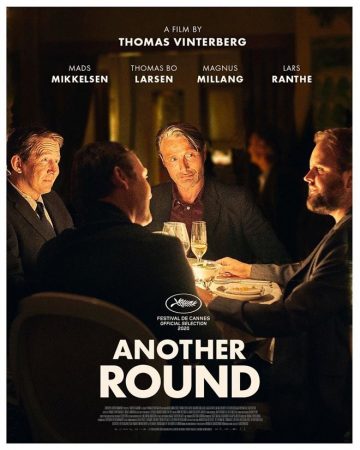
This dramedy from Denmark’s Thomas Vinterberg has received a puzzling amount of praise from critics and audiences. I, however, found it uninvolving and dull. The problem may be that, simply, I’m not Danish, and so didn’t connect with the story, which I understand is quite endemic to Denmark. There alcohol consumption is apparently far greater than just about anywhere else in the world, and figures into a plan made by a group of college professors whose ranks include Mads Mikkelsen. They decide to increase their alcohol consumption dramatically, in order to correct the alleged fact that man was born with insufficient blood alcohol levels. This results in a lot of staggering and slurred words, and greatly upends the lives of everyone involved. Of course nothing too awful occurs, which points up a most grievous annoyance: the inert neither-here-nor-there tone, which results in a film that’s never particularly funny, insightful or interesting.
8. ONWARD
A noteworthy film to me, simply because it was the last movie I saw in a theater prior to the coronavirus shutting everything down. I found it above average in the lexicon of Pixar cartoons, but (for me) that’s not saying much. The setting is an alternate universe USA populated by trolls, where we look in on a troll teenager (voiced by Tom Holland) looking to bring his father back from the dead. This he somehow manages to do, at least in part—he animates the old man’s bottom half, which accompanies the protagonist and his punk brother (Chris Pratt) on a quest to complete the job. What follows are a number of imaginative complications, but also a lot of kinetic silliness, with action sequences that aren’t especially exciting in the computerized animation format (being too evidently pre-planned and compartmentalized). Then there’s the sap-happy climax, which is plain obnoxious.
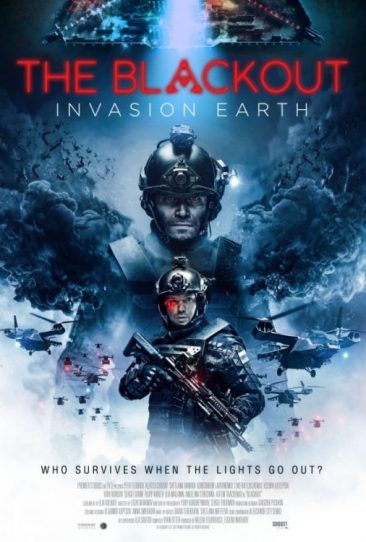 9. THE BLACKOUT (AVANPOST)
9. THE BLACKOUT (AVANPOST)
This example of wannabe Hollywood blockbuster moviemaking hails from Russia, which has turned out a CGI packed noise-maker that falls somewhere between DISTRICT 9 and WORLD WAR Z. The setting is a region in Russia that has somehow survived a worldwide blackout. The military is sent in to investigate, and they meet an alien with really long nostrils who reveals that his race created us—but it seems we’ve since gone out of control, forcing our alien overlords to take drastic measures to make things right. Visually the film is impressive, with above-average CGI and action scenes that are decent (if far from exceptional). Where it falls short is in the acting, which is mediocre at best (and even worse if you’re unfortunate enough to view the English dubbed version), the storytelling, which is quite disjointed, and the two hour-plus runtime, which is massively inflated.
10. EARTH AND BLOOD (LA TERRE ET LE SANG)
I’m all for minimalism in thrillers, but this French language Netflixer far exceeds the accepted quota. It involves a saw mill located in a vast forest that becomes the nexus for quite a few miscreants after an employee hides a stash of cocaine therein. This entails an extremely dull first half and an extremely repetitive latter one, with the proceedings devolving into an unexciting succession of stalking and shooting. As for the characters, none are sufficiently developed, and so I didn’t care about any of their fates.
11. LA LLORONA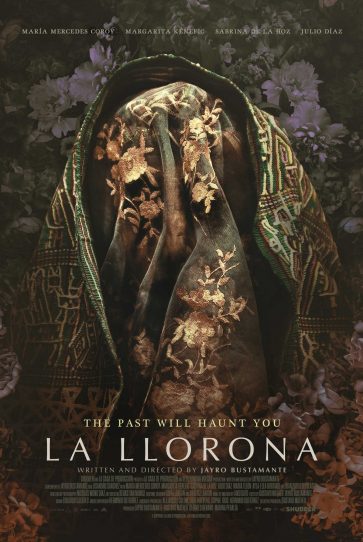
2020 was definitely the year for geezer horror, which in this French-Guatemalan co-production takes the form of an aging Guatemalan dictator (Julio Diaz) holed up in a mansion with his hapless family. Outside an unruly mob is determined to make Diaz pay for his crimes against humanity, whole within the house madness and paranoia predominate. A taut, tense and beautifully photographed work by writer-director Jayro Bustamante (of IXCANUL and TEMBLORES), although the balance between the horror and political elements is off, with the former often failing to fully register, and latter being too pushy and overt by far.
12. HILLBILLY ELEGY
Mainstream critics went after this film with a vengeance, but I say they missed the boat. They’re certainly not wrong about HILLBILLY ELEGY being a rotten movie, but they erred in politicizing their reviews, thus making themselves look like the out-of-touch coastal elites they are, and inspiring a cult of opposition that insists on singing the film’s praises. Viewing HILLBILLY ELEGY through a non-political lens (fact: it’s not about the BLM or #metoo movements, and so they probably shouldn’t be used as bludgeons to knock it down) one is left with a outrageous bit of inspiration porn detailing a young man’s escape from his white trash Appalachian family to a Better Life. The childhood flashback scenes are enjoyably melodramatic, with Amy Adams, as the protagonist’s abusive drug addicted mother, and Glenn Close, as his only slightly more stable grandmother, both overacting quite shamelessly. Director Ron Howard devotes a puzzling amount of screen time to Adams’ histrionics (even though hers is essentially a glorified supporting role) and on the protagonist’s present day attempts at finding work, which are, frankly, boring and unnecessary.
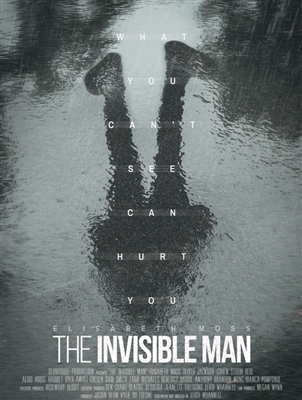 13. THE INVISIBLE MAN
13. THE INVISIBLE MAN
An invisible man themed movie that got around the problems faced by the makers of other such films by positioning itself as an in-name-only remake of the classic INVISIBLE MAN. In so doing it side-stepped any potential copyright claims by H.G. Welles’s heirs (which reportedly crippled Paul Verhoeven’s HOLLOW MAN). In truth the movie would probably have been better if writer-director Leigh Whannell had stuck more closely to Welles’s story, as the script for this new version is what sinks it. It’s well made, with lingering shots of empty sets that would have made Antonioni proud, and an excellent use of silence (something not too many American filmmakers nowadays seem to understand). But the film suffers from that most unfortunate Hollywood screenplay contrivance: the Idiot Plot. It’s that device, which decrees that for the plot to advance all the characters must behave like idiots, that explains why abused wife Elizabeth Moss and her asshole husband (Oliver Jackson-Cohen), who’s discovered the secret to invisibility, both behave so stupidly. Jackson-Cohen terrorizing his wife and framing her for murder probably isn’t an advisable course of action for one who wants her to deliver his baby, while Moss, as both a character and an actress, would have benefitted from acting a little less crazy.
14. BIRD TALK (MOWA PTAKOW)
The final script written by Poland’s late Andrzej Zulawski (1940–2016), brought to the screen by his filmmaker son Xawery. Xawery Zulawski’s previous films CHAOS (2006) and SNOW WHITE AND RUSSIAN RED (2009) aren’t up to the heights of his father’s filmography, and neither is BIRD TALK. The subject is modern-day Poland, which as viewed by the Zulawskis is in extremely bad shape, with a crazed odyssey of bad behavior that includes violent political demonstrations, a self-castration, an attempted assassination, a graveyard set music video and much excess hysteria. The overall impression is much like those of one of Andrzej Zulawski’s lesser efforts: energetic and outrageous yet also extremely long winded and lugubrious. Certain scenes capture the hysteria specialized in by the elder Zulawski, but Xawery tends to utilize fish eye lenses and upside-down compositions to impart what his father was able to conjure up far more organically.
15. RELIC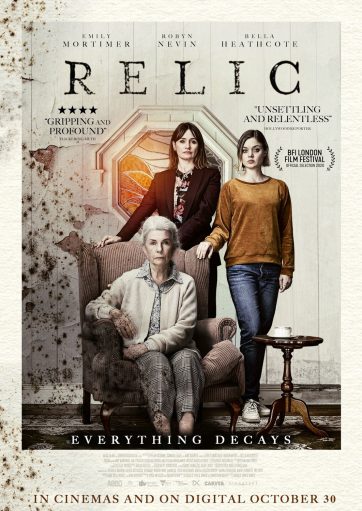
Not to be confused with the so-so 1997 monster movie, this is an Australian made woman-centered horror-fest that works due to its real-life resonance. It depicts an old woman (Robyn Nevin) suffering (it seems) from dementia, a condition that takes quite a toll upon her daughter (Emily Mortimer) and granddaughter (Bella Heathcote). The film is a brooding and disquieting slow burner that won’t appeal to everyone, but I suspect you’ll already know if you’re among RELIC’s target audience. I’m most definitely not among that audience, although I admire the craftsmanship displayed by director Natalie Erika James, whose first feature this was.
16. THE VAST OF NIGHT
A stylish but fatally indulgent alien invasion thriller set in the late 1950s. Director Andrew Patterson appears to have foreseen one of the major criticisms his film has received, that it’s little more than a feature length TWILIGHT ZONE episode, something he acknowledges by presenting it as an episode of a TWILIGHT ZONE-ish TV program. Unfortunately my other major criticism, that the film is essentially a short subject padded to feature length, goes unaddressed. Centered on a small town DJ who believes an alien invasion is afoot, the film contains extremely voluminous dialogue and show-offy camerawork that serves no evident dramatic purpose, although the Spielbergian ending is fairly strong. This is to say that the special effects packed final scenes aren’t too invigorating from a conceptual standpoint, but close things out on a fine note of moody apprehension.
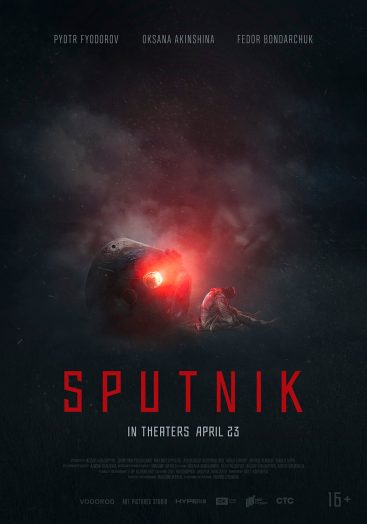 17. SPUTNIK
17. SPUTNIK
A Russian import that offers further evidence of the continuing influence of ALIEN. SPUTNIK, about an astronaut who returns to Earth with a monstrous parasite in his belly, should frankly be a lot better than the erratically paced and derivative (of the aforementioned ALIEN and nearly every other monster movie from the past three decades) product it is. What it has in its favor is a nifty CGI critter; monster movies, as we all know, are wholly dependent on the quality of the monster, and the one displayed here ranks with the best.
18. THE BURNT ORANGE HERESY
An adaptation of a 1971 novel by Charles Willeford, the quirkiest writer to emerge from the Hard Boiled school of 1950s era crime thrillers. The novel in my view was not one of Willeford’s better efforts, being a disjointed affair that begins as an odd commentary on the 1970s art world and ends as a none-too-thrilling thriller, so it’s hardly surprising that I wasn’t much taken with this film. Featured is Claes Bang as an amoral art critic and TENET’S Elizabeth Debicki as his sexy GF, who get caught up in a dark drama involving theft, forgery, murder and key supporting turns by Mick Jagger and Donald Sutherland. As in the novel, the above is prefaced by an extremely deliberate and involved build-up (during which director Giuseppe Capotondi, like Christopher Nolan in TENET, seems especially concerned with getting Debicki into as many revealing outfits as possible) that fails to justify the rather limp pay-off, which pivots on an errant fingerprint.
19. SPACESHIP EARTH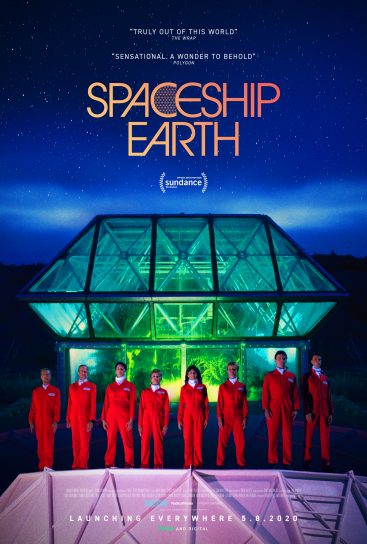
An almost-good documentary look at the Biosphere 2, an enclosed self-sustaining dome, and the 1991 experiment in communal living that took place therein. Said experiment, and the construction of the structure, was the work of some neo-hippies whose background is the subject of a rather dull opening third. Things pick up once the experiment gets underway; a great deal of verite footage exists of the eight people chosen to live inside the Biosphere 2, providing an up-close look at how the atmosphere in the place, which contained a mini-ocean, plants and trees, went from joyous to poisonous as the oxygen was depleted and the participants gave way to infighting. The ending is a sad one, with the Biosphere 2 being corporatized by a consortium led by former Trump lackey Steve Bannon. The major problem with this film is we never really get to know any of the people headlining this saga, with director Matt Wolf providing only the sketchiest of character detail. He lavishes far more time on the Biosphere 2 itself, making sure we see it from every conceivable angle both inside and out, and I’m not sure this was the correct approach.
20. HOST
One of several zoom thrillers from 2020, in which, as in 2014’s UNFRIENDED, the entire film takes place on a computer screen, with several young folk engaged in a zoom chat. The subject of this 57 minute British made entry is an online séance, which these zoomers unwisely perform, and call up a bunch of ghosts who like to jump out of shadows and toss people around. The deliberately paced early scenes are genuinely shivery and atmospheric, which makes it all the more irritating when the proceedings degenerate into a sub-BLAIR WITCH PROJECT shock fest. See UNSUBSCRIBE instead.
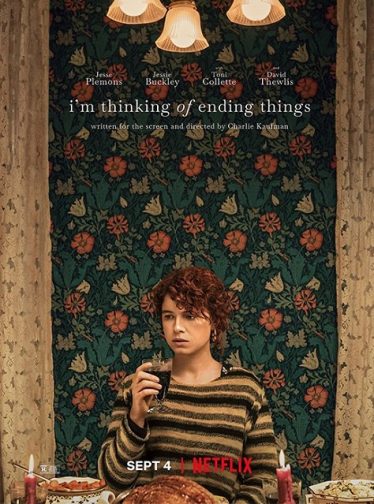 21. I’M THINKING OF ENDING THINGS
21. I’M THINKING OF ENDING THINGS
A most unlikely offering from writer-director Charlie Kaufman, adapting Iain Reid’s 2016 literary horror novel. This film, the third to be directed by Kaufman, features an unidentified young waitress (Jessie Buckley) embarking on a road trip with her boyfriend (Jesse Plemons) during a snowstorm, with their increasingly surreal odyssey intercut with scenes of an elderly janitor going about his rounds in a high school. In adapting this material Kaufman was stuck with a near-insurmountable challenge, given that it’s heavily dialogue driven and takes place largely in a car. Kaufman meets the challenge with a great deal of formalistic weirdness that culminates in a downright obnoxious climax whose particulars—which include incongruous dance numbers, a cartoon pig and a sudden jump forward in time—will be completely incomprehensible to anyone who hasn’t read the novel.
22. POSSESSOR
The second feature by Brandon Cronenberg, who’s created a film that’s heavily informed by the work of his father David. It involves a female assassin (Andrea Riseborough) who carries out her duties by possessing the bodies of others; her latest assignment has her inhabiting a recently deceased himbo in whose body she’s set to kill a wealthy scumbag, with results that are quite messy. Cinematically Brandon Cronenberg demonstrates a fair amount of flair, but from a conceptual standpoint the film is unsatisfying. Like Brandon C.’s earlier ANTIVIRAL, POSSESSOR is marked by interesting ideas that aren’t paid off, leaving us with a promising but unsatisfying viewing experience.
Still Waiting On…
THE AMUSEMENT PARK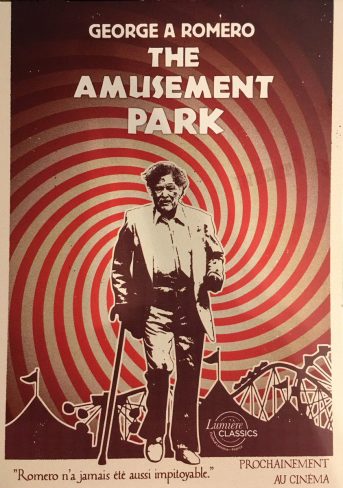
Long thought to be lost, this is a 1973 mini-feature directed by George Romero, a PSA on ageism that was so bleak and upsetting its Lutheran charity backers suppressed it for nearly five decades.
ANNETTE
A film that was supposed to be released in 2020 but wasn’t. It’s a most eccentric musical by France’s Leos Carax, starring Adam Driver and Marion Cotillard.
BENEDETTA
This Paul Verhoeven lesbian nun biopic has been in production—and post-production—seemingly forever. It’s supposed to finally bow in 2021.
THE CARD COUNTER
The latest film by Paul Schrader, a revenge thriller involving Oscar Isaac as a casino hustler, is said to extend the hot streak Schrader commenced with FIRST REFORMED.
DUNE
A two-part adaptation of Frank Herbert’s classic novel by the phenomenally talented Denis Villeneuve, and the only upcoming remake to which I’m looking forward.
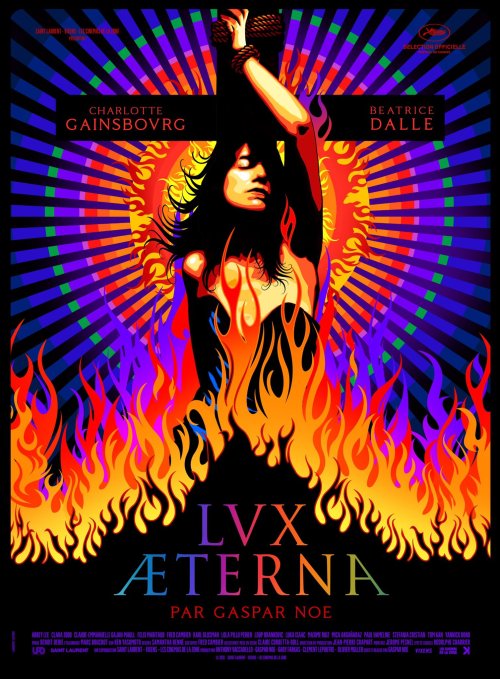 LUX ÆTERNA
LUX ÆTERNA
I’ve already reviewed this one, a typically innovative and confrontational film from the always-edgy Gaspar Noe.
MACBETH
In which Joel Coen (of the Coen Brothers) takes on the Bard’s darkest tale, with Denzel Washington in the lead.
NIGHTMARE ALLEY
Filming on Guillermo Del Toro’s adaptation of William Lindsay Gresham’s classic novel was halted due to the coronavirus, but I hear the production has gotten back underway, and is almost ready for release.
SIBERIA
Yet another film we were supposed to get in 2020, an Abel Ferrara directed “exploration into the language of dreams.”
UNDERGODS
A sci-fi feature, shown at the 2020 Fantasia Fest, about which one pundit proclaimed “Sorry, BLADE RUNNER, you have been usurped.” We’ll see about that!
YOU CAN’T WIN
Another project whose release is seemingly always being announced and then pushed back. It’s an adaptation of Jack Black’s fabled hobo autobiography by THE WOMAN CHASER’s Robinson Devor.
